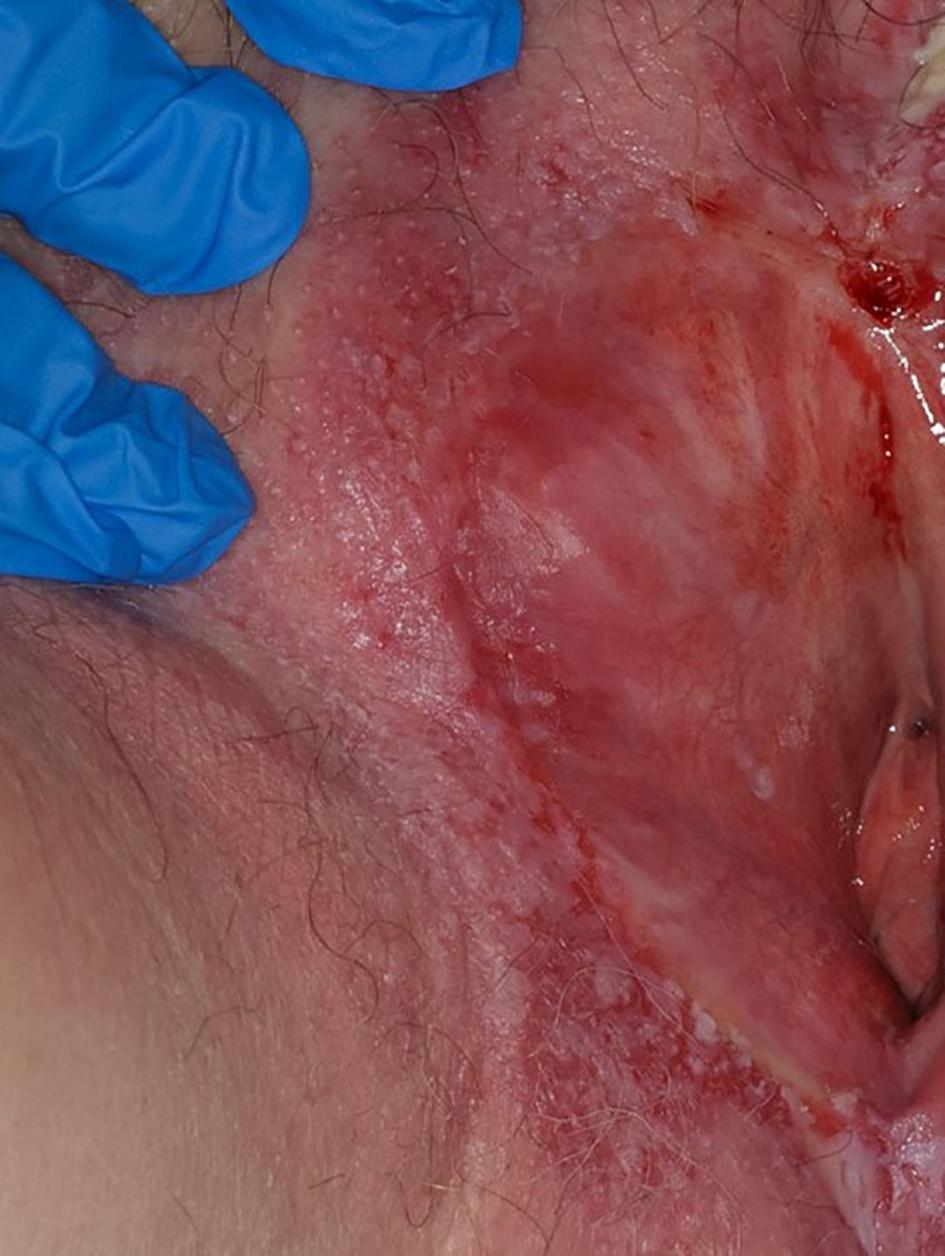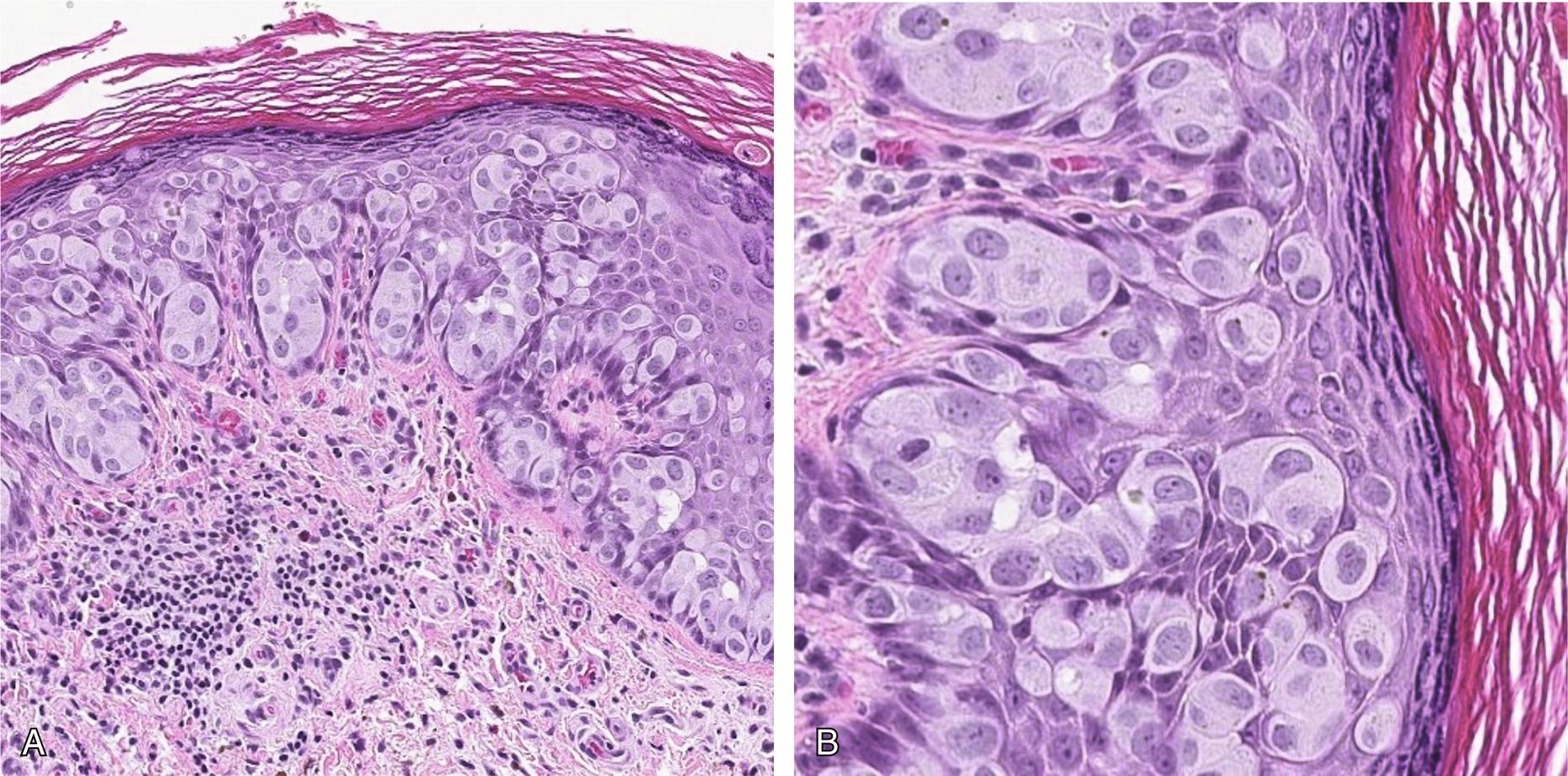Physical Address
304 North Cardinal St.
Dorchester Center, MA 02124
A 72-year-old patient presents with a 6-month history of vulvar pruritus and irritation. She has tried multiple antifungal medications with no improvement. On physical examination, she has an erythematous plaque-like rash involving the perineum and bilateral labia majora ( Fig. 19.1 ). You perform a biopsy, which reveals extramammary Paget disease. What additional testing is indicated? How would you treat this patient?

Extramammary Paget disease is a rare intraepithelial neoplasm that presents as eczematous, pruritic plaques of the perineal, perianal, inguinal, and/or axillary regions of both men and women. In Europe, the incidence of extramammary Paget disease is 0.7 per 100,000 persons per year, and women make up approximately 80% of cases. Conversely, a male predominance is noted in Asian populations. Vulvar extramammary Paget disease most commonly occurs in postmenopausal Caucasian women with a mean age at presentation of 65 years. However approximately 15% of cases of vulvar extramammary Paget disease in the United States occur in non-Hispanic Asians or Pacific Islanders. While most vulvar extramammary Paget disease is intraepithelial/noninvasive, invasive disease is identified in 15%–20% of cases and accounts for 1%–2% of vulvar malignancies.
Local recurrence is common in patients with extramammary Paget disease, but mortality is rare. Most series report 95%–100% survival among patients with noninvasive or microinvasive extramammary Paget disease, and the risk of developing invasive or metastatic extramammary Paget disease after treatment for noninvasive extramammary Paget disease is extremely low. Five-year survival in most series of invasive extramammary Paget disease is 40%–80%. However, patients who present with metastatic disease have worse prognosis, with 5-year overall survival as low as 0%–15% in small series.
The etiology of extramammary Paget disease is poorly understood; however, several origin theories exist including that Paget cells (1) arise from apocrine glands or stem cells in the epidermal basal layer of the skin or hair follicle, (2) originate from mammary-like glands, or (3) originate from Toker cells. Toker cells are CK7 positive cells that normally occur in the nipple, areola, and vulva. They can become hyperplastic and atypical, which gives a similar appearance to that of Paget cells. Clinically, vulvar extramammary Paget disease is often classified as either primary or secondary extramammary Paget disease based on Wilkinson criteria ( Table 19.1 ). Primary vulvar extramammary Paget disease is a cutaneous neoplasm, which is either comprised solely of Paget cells or is associated with a contiguous cutaneous malignancy (i.e., direct extension from an adjacent malignancy). Secondary extramammary Paget disease is associated with noncutaneous, non contiguous malignancy (i.e., malignancy diagnosed at a distant site without direct extension).
| Classification | Subtype |
|---|---|
| Primary (cutaneous) | 1a Cutaneous vulvar noninvasive EMPD |
| 1b Cutaneous vulvar invasive EMPD (dermal invasion) | |
| 1c Cutaneous vulvar EMPD contiguous with underlying vulvar adenocarcinoma | |
| Secondary (noncutaneous) | 2 Vulvar EMPD originating from rectal or anal adenocarcinoma |
| 3 Vulvar EMPD originating from urogenital neoplasia |
Rates of secondary malignancies associated with extramammary Paget disease vary in the literature, ranging from 4% to 58% in published series. This discrepancy is likely due to varying definitions of “associated” malignancies, as some series include contiguous cutaneous malignancies and others include only occult or distant cancers. Chronology of “associated” malignancies also varies, as some studies only include cancers diagnosed within 1–2 years of extramammary Paget disease, while others include remote malignancies. Most of these studies lack comparison groups (specifically, true age-associated rates of specific cancers), so the true association between extramammary Paget disease and distant or contiguous cancers is not clear. Using SEER data, Kilts et al. observed a rate of synchronous cancer of only 2.8%, and the majority were breast, gastrointestinal (GI), or skin. Additionally, the risk of developing a subsequent secondary cancer compared to age and gender-based population controls was elevated (standardized incidence ratio (SIR) 3.9 (95% CI 2.2–4.7)).
Schmitt et al. defined associated malignancies as “contiguous” if direct extension from an adjacent malignancy was noted on histology and as “noncontiguous” if cancer was diagnosed at a distant site without direct cytologic extension. Associated noncontiguous cancers were deemed “synchronous” if identified within 1 year of extramammary Paget disease diagnosis. In their series of male and female patients diagnosed with extramammary Paget disease at Mayo Clinic, synchronous, noncontiguous malignancies were diagnosed in 8% of patients with vulvar extramammary Paget disease, and contiguous malignancies were found in 18%. Other series report somewhat higher rates of synchronous, noncutaneous malignancies (11%–46%) in vulvar extramammary Paget disease, specifically, though definitions were not standardized in these studies.
Risk factors for vulvar extramammary Paget disease include advanced age and Caucasian race. While several genomic alterations have been noted on somatic testing (HER2 amplification, ERBB2, TP53, PIK3CA, and PTEN mutations, FOXA1 overexpression), there are no known germline mutations associated with increased risk of extramammary Paget disease. Environmental risk factors are also unknown.
Paget disease is usually a red to pink lesion that is slightly raised and may be focal but can also diffusely involve the vulva with extension into the vagina, cervix, and anus. These features overlap with more common dermatoses and high grade squamous intraepithelial lesion (VIN 3).
Primary Paget disease is most often an entirely intraepithelial process ( Fig. 19.2A ). Paget disease is characterized by the presence of large, atypical cells with abundant, pale cytoplasm and large nuclei with prominent nucleoli ( Fig. 19.2B ). The cells can form clusters or be distributed as single cells and are most often located in the basal or parabasal portion of the epithelium, but can extend into the more superficial layers. It is commonly associated with a superficial dermal inflammatory response. This form of Paget disease is thought of as an in situ adenocarcinoma of the vulva. In resection specimens the margin status should be carefully evaluated and reported.

However, Paget disease can progress resulting in invasion of the dermis by the neoplastic cells. The invasion can be subtle with single cells extending into the superficial dermis or more readily appreciated if small groups of invasive cells are present. If invasive Paget disease is identified, the depth of invasion should be reported in addition to the presence or absence of invasive disease at the surgical margins.
Paget disease must be distinguished from other intraepithelial processes such as high grade squamous intraepithelial lesions and melanoma. Although it is usually possible to distinguish Paget disease from these entities, ancillary studies can be helpful in difficult cases. Paget disease cells diffusely express CK7, which is negative in both squamous intraepithelial lesions and melanoma. p16 can be positive in Paget disease so it is not useful in the differential with HPV-associated squamous intraepithelial lesions, however it will be negative for HPV by in situ hybridization. Melanoma is not only negative for CK7, but its presence can be verified using S100, HMB-45, and Melan-A which are all negative in Paget disease. In addition, Paget disease must not be confused with the intraepithelial involvement of the vulva by invasive urothelial or rectal adenocarcinoma (referred to as secondary Paget disease). Uroplakin-3, CDX2, and CK20 can be used in this case as Paget disease is usually negative for all three markers (CK20 can be focally positive in Paget disease). CK7 can also be helpful in assessing the margin status of resections for Paget disease as well as for identifying invasive Paget disease if it is indefinite on H&E stained slides.
Primary vulvar Paget disease (as discussed above) is thought to arise from stem cells in the skin adnexal structures or the epidermis. A recent study found alterations in the following genes: PIK3CA (35%), ERBB2 (27%), and TP53 (27%). Amplification and deletion of specific regions of the genome as well as hypermethylation of CDH1 have also been identified. The presence of ERBB2 alterations (amplification and mutations) suggest that patient’s with HER2 positive Paget disease by IHC may be candidates for targeted therapy and the presence of PIK3CA mutations may render patients sensitive to inhibitors of the PI3K pathway.
Vulvar extramammary Paget disease typically presents as a violaceous rash with intense pruritus and vulvar irritation, though 10%–15% of patients present with an asymptomatic rash. The diagnosis is often delayed, as signs and symptoms are attributed to candidiasis, lichen sclerosis, intertrigo, or contact dermatitis. In one series, patients experienced a median of 2 years of pruritus before their diagnosis of vulvar extramammary Paget disease.
On physical exam, patients with extramammary Paget disease have a unifocal or multifocal, well-demarcated, eczematous rash with a plaque-like appearance and an irregular border. Raised white areas of hyperkeratosis can exist on an erythematous background, giving a “cake-icing” or “strawberries and cream” appearance ( Fig. 19.1 ). This rash may extend beyond the perineum to involve the distal vagina, perianal and anal areas, and groin. Physical exam should include inspection of the entire genitalia and groins, as well as palpation of inguinal nodes. A breast exam, pelvic exam, and rectal exam should also be performed to assess for underlying malignancy. Given the data above regarding contiguous malignancies, more detailed focused examinations should be performed in cases with lesions contiguous with the urethra and anus in particular.
The differential diagnosis of vulvar extramammary Paget disease includes benign conditions such as vulvovaginal candidiasis, lichenoid sclerosis, lichenoid simplex chronicus, psoriasis, contact dermatitis, Pagetoid reticulosis, and Pagetoid vulvar intraepithelial neoplasia as well as malignant conditions including superficial spreading malignant melanoma and vulvar squamous cell carcinoma. Histologically, the differential diagnosis for Paget cells includes melanoma, pagetoid spitz nevus, clear cell papulosis, sebaceous carcinoma, cutaneous T-cell lymphoma, eccrine porocarcinoma, and Langerhans cell microabscess.
Become a Clinical Tree membership for Full access and enjoy Unlimited articles
If you are a member. Log in here